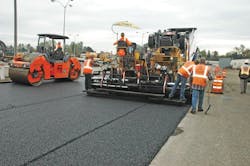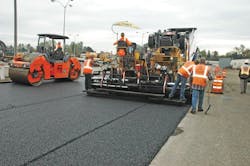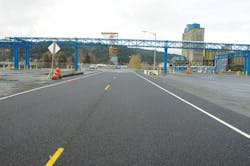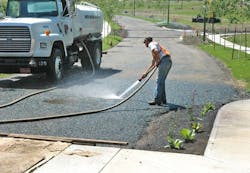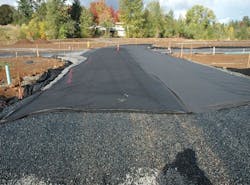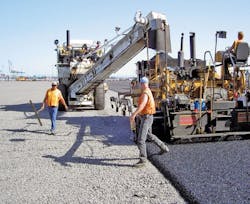Thrice a success
Rain runs off pavement and causes problems.
It changes the temperature of neighboring rivers and streams, carries garbage into wetlands and creates headaches for people whose driveways slope toward their garages. To avoid these and other problems, new pavement projects are required to have permits, which require designers to estimate storm-water runoff and design catch basins, pipes and detention basins to protect neighboring areas. But how much time does it take to get permits? A lot. And how much does it cost? A lot.
Crews lay down a lift of porous pavement on Terminal 4.
The completed Terminal 4 project.
To save time and money, owners in Oregon use porous pavement. The following three Oregon projects show, respectively, the benefits and versatility of employing porous pavement.
Impervious and porous
At the Port of Portland’s Terminal 4, large trucks pick up grain and other products via an access road. Early in 2015, the Port determined that the road needed improvement. Covered with impervious asphalt, it had serious drainage problems. After two previous successes, the Port looked to porous pavement.
The challenges included a 90° turn, a large sloped intersection and insufficient drainage structures. For super-elevated parts, the designers put impervious pavement on the high side and porous on the low. Porous pavement was used for flat straightaways, and traditional impervious pavement was used at the 90° turn. The intersection was mixed, with impervious pavement in wheel-turning areas and porous everywhere else.
Impervious asphalt was used in turning areas because it has a tighter surface texture, which reduces the risk of truck tires pulling apart the aggregate at the surface when turning. At the sloped intersection, the uncompacted subgrade was terraced (stepped) to provide a flat infiltration surface to promote even infiltration (with a sloped bottom the storm water would hit the slope and run down to the low point, potentially causing a sinkhole). Small berms were placed at the terrace edges to prevent storm water from flowing over the edges to lower terraces. The pavement surface was about 65% porous.
The Pringle Creek subdivision in Portland was constructed with sustainability in mind.
The original design prohibited recycled asphalt pavement (RAP) in the impervious pavement because the Port must meet Federal Aviation Administration (FAA) requirements, which prohibit RAP. The original design also specified a standard asphalt binder for the porous pavement, and featured a triangle-shaped interface between the impervious and porous pavement at the intersection.
The Port asked the Asphalt Pavement Association of Oregon (APAO) to review the preliminary design. The APAO was able to confirm that the FAA prohibition on RAP did not apply, which resulted in an allowance of 30% RAP in the impervious pavement. The resulting savings offset the additional cost for a polymer-modified binder in the porous pavement, which the APAO recommended for all porous pavements. Finally, it was recommended that the triangular interface be squared off so that it could be paved with a paver rather than by hand.
As with an earlier project (see, “A lot of porous”), Lakeside Industries paved the project. Lakeside paved on low traffic days, which reduced traffic delay and prevented drain-down. There was not enough room to use a material transfer vehicle to load the paver from the side so Lakeside loaded the paver from the front with end-dump trucks. Lakeside’s laborers raked disturbances in front of the paver as they went and a thicker (7 in.), multiple-lift pavement layer helped yield a smooth pavement surface despite disturbances in the choker course that remained after raking.
Lakeside Industries completed the paving in October 2015. The project fixed Terminal 4’s drainage problem, demonstrating how porous pavement could be used side by side with impervious pavement.
A lot of porous
The Terminal 4 project had the advantage of winning in hindsight. In early 2006, ports in the northwest were competing for a contract with a car importer who wanted to offload cars from barges and store them until they were picked up for delivery to dealers. The importer needed 40 acres of parking and needed it ready by the end of 2006. The Port of Portland had the perfect spot, but it was mostly unpaved. Traditional impervious pavement would have increased storm-water discharge to the Columbia River, which is next to the Port and closely monitored by environmentalists and agencies. Getting permits would have taken a year and put the Port out of contention for the contract.
The base and ATPB layers were covered with geotextile to protect it over the winter months.
Crews applied a two-layer system to prevent clogging in the lifts.
A Port engineer had experience with porous pavement and thought it might help. He found that because porous pavement would have no storm-water discharge, it would eliminate the permitting process. In telling local contractors about the project, he found that their worries about producing what they considered a specialty product disappeared when he mentioned that the Port wanted to pave 40 acres.
The Port and its consultants designed a standard porous pavement (from the bottom-up): uncompacted subgrade (to allow for infiltration); non-woven geotextile (to protect against fines entering the layers above); a 10-in. reservoir course of uniformly graded aggregate with 40% voids (for storm-water storage); a 1-in. choker course (smaller aggregate on top of the reservoir course to provide a more stable surface for construction equipment); and 3 in. of porous pavement. The porous pavement mix design called for a 1.5-in. nominal maximum aggregate size (NMAS) open-graded mix, with an asphalt binder rated two grades stiffer than what is required by local climate conditions.
Common porous pavement challenges include drain-down (asphalt binder sliding off the aggregate) and the instability of the base rock layers due to construction equipment disturbing the surface—think of driving on marbles—and disturbed base rock can cause bumps in the pavement surface. Drain-down must be prevented because keeping the asphalt binder coating on the aggregate is essential to the life of porous pavement, and because any binder that slides off the aggregate could pool under the pavement layer and clog the system. Hotter mixing temperatures increase drain-down; if asphalt binder is too hot, it will not stick to the aggregate. Contractors must balance preventing drain-down against getting the asphalt to the site while it is still hot enough to compact, a task more complicated than it might seem.
Lakeside Industries delivered asphalt to its paver from the side rather than from the front by using a material-transfer vehicle, allowing for a smooth surface in front of the paver, which resulted in a smooth finished pavement surface. Paving at night shortened haul times and allowed Lakeside to dedicate its asphalt plant to the porous mix for the entire shift. Shorter haul times minimized mix cooling before placement, which prevented drain-down because Lakeside did not need to use extra-hot mixing temperatures. Dedicating its plant to porous pavement for entire shifts minimized waste and produced a consistent mix.
To date, the importer has used the parking area for nine years. The pavement drains well, has no cracking and shows almost no distress. Although there is minor surface raveling in isolated spots where larger vehicles turn their wheels to park, there is no negative effect on the parking area. Although a polymer-modified binder would have prevented the raveling, it is hard to argue that the Port should have spent more money for a modified binder when it is getting great performance.
The Port is expecting another nine years of great performance before considering preservation options, namely a porous overlay or a grind-and-inlay.
Two-layer system
Another 2006 project showed the versatility of porous pavement—the Pringle Creek subdivision.
In 2006, a developer wanted to build a subdivision that maximized sustainable practices—and determined that porous pavement would reduce impervious surfaces, provide for natural groundwater recharge and eliminate drainage structures.
The developer needed to perform significant construction over the wet Oregon winter, and needed a road for construction traffic. Adding to the challenge, the site was unavailable to the contractor until October, right at the start of the wet season. Knowing that subdivision construction is messy and that dirt must be kept off porous pavement to prevent clogging, the project team, consisting of the contractor, the designer and the APAO, developed a two-layer system.
One layer was an asphalt-treated permeable base (ATPB) and the other was a porous pavement wearing course that would be placed later. The contractor would construct the typical base layers (reservoir and choker courses), and then pave the ATPB. Construction traffic would use the ATPB over the winter, and the porous pavement top lift would be paved the following spring or summer.
The final design called for (from the bottom-up): uncompacted subgrade; non-woven geotextile; a 10-in. reservoir course with 40% voids; a 1-in. choker course; 3 in. of ATPB; and 1.5 in. of porous pavement. A 1- to 2-ft-wide stone trench was specified along the pavement edge to provide an alternate path for storm water to reach the reservoir course if the pavement clogged.
The ATPB was a 3⁄4-in. NMAS, open-graded mix with 30-35% voids, about double the voids in typical porous pavement, and 3% asphalt. The ATPB was strong enough to support construction traffic and the additional voids made it much less likely to clog than a typical porous pavement. Because the porous pavement top lift was 1.5 in. thick, a 3⁄8-in. NMAS, open-graded mix was used, because with porous pavement, the NMAS should be no bigger than one-fourth of the lift thickness.
Concerned about providing enough support for construction traffic and clogging the subgrade by working in muddy conditions, the contractor, North Santiam Paving, excavated an additional 8 in. and placed 4 in. of minus washed pit-run gravel directly on the subgrade. The additional layer added strength, protected the subgrade, and eliminated the need for non-woven geotextile on the subgrade since fines would not migrate up through the gravel layer. After North Santiam Paving constructed the base layers and paved the ATPB, it covered the ATPB with geotextile for added protection over the winter months.
Construction traffic used the geotextile-covered ATPB throughout the winter with no problems. In the spring, North Santiam Paving removed the geotextile, cleaned the surface and paved the porous pavement.
The two-layer system lessened the risk of clogging because the ATPB, directly under the porous pavement top lift, had significantly more void space than porous pavement; the bigger the voids, the harder to clog. At Pringle Creek, any clog would occur in the top 1.5 in. The result was a porous pavement that is hard to clog, but also relatively easy to unclog.
To date, the pavement is performing exceptionally and has retained a “new” look.
Porous pavement can be designed for almost any pavement use and loading condition. A two-layer system using porous pavement on top of an ATPB can be used where a temporary road surface is needed or for added protection against clogging. Oregon’s experience, on three distinct yet related occasions, shows that porous pavement also lasts. As the construction industry rebounds, expect to see more porous pavement—and less storm-water runoff—especially near environmentally sensitive areas. AT
